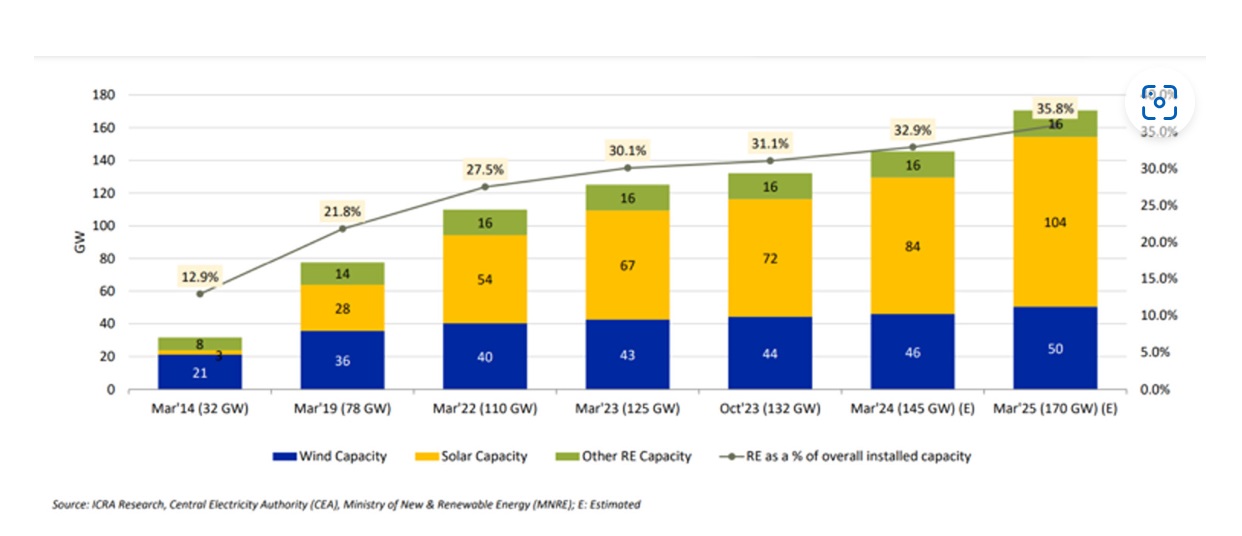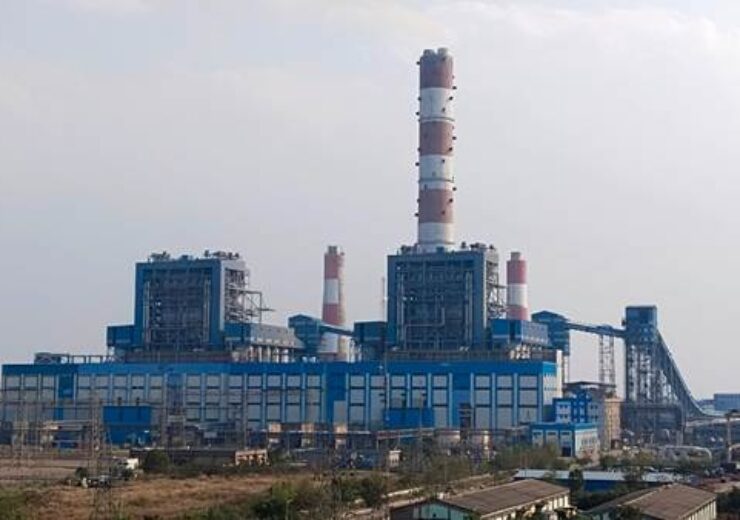https://www.pv-magazine.com/2023/12/08/ ... arch-2025/India’s installed PV capacity expected to hit 104 GW by March 2025
Currently, India has an installed solar power of around 73 GW, according to ICRA. New solar capacity additions in fiscal year 2024 and fiscal year 2025 are estimated at 17 GW and 20 GW, respectively.
DECEMBER 8, 2023 UMA GUPTA
CRA expects India’s installed renewable energy capacity to increase to about 170 GW by March 2025 from 132 GW as of October 2023. The largest portion of this capacity addition will be driven by solar installations, which will grow to 104 GW by March 2025 from 72 GW as of October 2023. New solar capacity additions in fiscal year 2024 and fiscal year 2025 are estimated at 17 GW and 20 GW, respectively.
ICRA said renewable energy capacity additions will increase further after March 2025 due to a significant improvement in tendering activity in the current fiscal with over 16 GW of projects, including 11.2 GW solar, and another 17 GW expected to come from the tenders held by the central nodal agencies. This is in line with the 50 GW annual bidding trajectory announced by the Indian government in March 2023.
............................
Politique énergétique en Inde
Modérateurs : Rod, Modérateurs
- energy_isere
- Modérateur

- Messages : 90152
- Inscription : 24 avr. 2005, 21:26
- Localisation : Les JO de 68, c'était la
- Contact :
Re: Politique énergétique en Inde
L'Inde devrait toucher les 100 GW de solaire au début 2025.
- energy_isere
- Modérateur

- Messages : 90152
- Inscription : 24 avr. 2005, 21:26
- Localisation : Les JO de 68, c'était la
- Contact :
Re: Politique énergétique en Inde
Projet de centrale step de 750MW en Inde.
https://www.nsenergybusiness.com/news/n ... e-project/NHPC to invest $481m in 750MW Kuppa hydro storage project in Gujarat, India
By NS Energy Staff Writer 05 Jan 2024
NHPC has signed an MoU with Gujarat Power Corporation Limited (GPCL), a power generation company promoted by the Government of Gujarat, to develop pumped hydro storage projects, and contribute to the national objective of clean and green energy
India’s state-run hydropower company NHPC is set to invest around INR40bn ($481m) in the proposed 750MW Kuppa pumped hydro storage project, located at Chhota Udaipur, Gujarat.
NHPC has signed an MoU with Gujarat Power Corporation Limited (GPCL), a power generation company promoted by the Government of Gujarat.
Through the MoU, NHPC and Gujarat’s state government plan to develop and use pumped hydro storage projects as an effective solution for energy storage.
It also contributes to the national objective of clean and green energy, which includes achieving 500GW of renewable energy capacity by 2030 and a ‘Net Zero’ target by 2070.
Also, the proposed pumped hydro storage project in Gujarat is expected to create significant employment opportunities and boost the local economy.
NHPC is one of India’s leading hydropower companies, with a total installed capacity of 7,097.2MW of renewable energy, including wind and solar.
...........................
- energy_isere
- Modérateur

- Messages : 90152
- Inscription : 24 avr. 2005, 21:26
- Localisation : Les JO de 68, c'était la
- Contact :
Re: Politique énergétique en Inde
https://www.h2-mobile.fr/actus/inde-fut ... -low-cost/L'Inde, future championne de l'hydrogène vert low-cost ?
27.01.2024 JEAN-LUC PONCIN h2-mobile
Le cabinet d’étude Wood Mackenzie vient de publier un rapport qui met en évidence que l’Inde, grâce à un fort potentiel solaire et éolien, pourrait produire de l’hydrogène vert à un prix de 4,30 dollars /kg d’ici à 2030. Seule la Chine fait mieux en Asie. Reste désormais au pays atteindre son objectif de fabrication d’hydrogène renouvelable de cinq millions de tonnes d'ici aux années trente. Et ce n’est pas gagné !
On le sait peu, mais l’Inde bénéficie d’un ensoleillement très important, 1 200 à 2 300 kWh/m²/an suivant les régions (en comparaison, la France oscille entre 1 000 et 1 600) ; et d’un vent régulier et puissant , dont la vitesse moyenne oscille entre 4 et 6 mètres par seconde (France 3 à 5 m/s). Si l’on ajoute à cela un réseau hydrographique assez dense, la terre du Mahatma Gandhi, dispose d’un formidable potentiel de production d’énergie renouvelable.
Conséquence de cette situation extrêmement favorable, L’Inde est très bien placée dans la course à la production d’hydrogène vert, tant en volume qu’en termes de coûts. Ce que le gouvernement de New Delhi a parfaitement compris, décidant d’accompagner le développement du nouvel or vert en mobilisant 2,1 milliards de dollars (1,9 milliards d’euros) et en exemptant les producteurs d'hydrogène vert des charges liées aux réseaux d’acheminement.
Cependant, le cabinet Wood Mackenzie souligne que, si ces efforts devraient permettre d’atteindre un prix du kilogramme d’hydrogène vert autour de 4 euros, le niveau de production lui risque de rester bien en deçà des prévisions.
La production d’hydrogène vert concurrencée par le besoin en électricité du pays
En effet, l’étude Wood Mackenzie « Chance of a lifetime: Can India show the developing world a unique path to net zero ? », confirme l’objectif gouvernemental initial, estimant qu’il faudra 125 GW de nouvelles énergies renouvelables pour atteindre l'objectif de production d'hydrogène vert de cinq millions de tonnes par an du pays d'ici 2030.
Or, outre le retard pris dans la construction de nouvelles installations, les besoins en électricité du pays tout entier sont énormes et les nouvelles productions devront aussi accompagner la décarbonation de l’électricité produite en Inde.
Au final, « ce sont environ 4 millions de tonnes par an d’hydrogène à faible teneur en carbone qui seront probablement disponibles d’ici 2030, ce qui représente environ 5 % de la production mondiale ». Non seulement l’objectif 2030 risque de ne pas être atteint, mais Wood Mackenzie questionne aussi la viabilité de la trajectoire pour 2050, date à laquelle le pays devra atteindre zéro émission nette.
L’inde a besoin de 55 millions de tonnes d’hydrogène vert par an
En effet, le cabinet de recherche estime que l’Inde aura besoin de 55 millions de tonnes par an d’hydrogène propre d'ici à 2050. 35 millions seront produites dans le pays tandis que le reste sera importé.
Compte tenu de ces éléments, Wood Mackenzie ajoute qu’un moyen d’accélérer la transition de l’Inde vers le zéro émission nette serait d’augmenter le prix du carbone (le doubler) pour contraindre les entreprises et industries à investir dans l’hydrogène. Piste qu’explore l’Inde avec prudence, mais qui vient néanmoins de lancer son propre marché de crédits carbone. Plafonnant les émissions de gaz à effet de serre des entreprises de secteurs tels que le raffinage du pétrole, le ciment, le fer et l’acier et les engrais, tout en permettant l’échange de crédits pour les émissions inférieures à ce plafond ; il pourrait contribuer à donner un coup d’accélérateur aux projets hydrogène.
- energy_isere
- Modérateur

- Messages : 90152
- Inscription : 24 avr. 2005, 21:26
- Localisation : Les JO de 68, c'était la
- Contact :
Re: Politique énergétique en Inde
https://www.evwind.es/2024/02/02/india- ... ects/96448India invites bids for 4 GW offshore wind energy projects
February 2, 2024 evwind
Developers who win the bids will be able to sell electricity directly to consumers under the open access regime, the government said
Bansari Mayur Kamdar, Reuters News.
India has invited bids for the development of four offshore wind power projects of 1 gigawatt (GW) each off its south-eastern coast, the government said in a statement on Friday.
Developers who win the bids will be able to sell electricity directly to consumers under the open access regime, the government said, adding that no viability gap funding will be provided for the projects.
- energy_isere
- Modérateur

- Messages : 90152
- Inscription : 24 avr. 2005, 21:26
- Localisation : Les JO de 68, c'était la
- Contact :
Re: Politique énergétique en Inde
Modi inaugure une centrale thermique à charbon de 1.6 GW (et qui n'est que la phase 1) :
https://www.nsenergybusiness.com/news/i ... wer-plant/Indian PM Modi inaugurates stage-1 of Lara super thermal power plant
Located in south-east of Raigarh district, stage-1 of the Lara thermal power station has been built with an investment of nearly INR158bn ($1.91bn)
By NS Energy Staff Writer 26 Feb 2024
Modi also laid foundation stone for the second phase of the Lara super thermal power station. (Credit: PIB DELHI | Dheep Joy Mampilly)
Indian Prime Minister Narendra Modi has officially inaugurated the 1.6GW phase 1 of NTPC’s Lara super thermal power station in Chhattisgarh, India.
Modi has also laid the foundation stone for the second phase of the coal-based super critical pit head thermal power project. Like the first phase, the second phase of the power station will have two units of 800MW each.
Located in south-east of Raigarh district, stage-1 of the Lara thermal power station has been built on about 1,400 acres of the total 2,400 acres area allocated for the project.
The first phase of the thermal project entailed a total cost of nearly INR158bn ($1.91bn).
The second phase of the Lara thermal project, which will be constructed on the available land of phase 1, will require an investment of approximately INR155.3bn ($1.87bn).
The Lara thermal power station will deliver half of the electricity it produces to the state of Chhattisgarh. Other states including Gujarat, Maharashtra, Madhya Pradesh, and Goa along with the union territories of Daman and Diu and Dadra and Nagar Haveli will also benefit from the project.
All the units at the Lara thermal power station are anticipated to achieve lower specific coal consumption and carbon dioxide emissions. These will be attained by leveraging super critical technology and ultra super critical technology for stage-1 and stage-2 of the power project, respectively.
By making use of merry-go-round (MGR) system, coal for the pit-head power station will be delivered from NTPC’s Talaipalli coal block.
The Lara super thermal power station will also generate direct and indirect employment opportunities in the region.
Last week, Prime Minister Modi inaugurated two new pressurised heavy water reactors (PHWRs) at the Kakrapar atomic power station (KAPS) in Gujarat. The Unit 3 (KAPS-3) and Unit 4 (KAPS-4) projects, which are built by the Nuclear Power Corporation of India (NPCIL), have a capacity of 700MW each.

